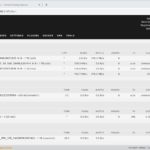If the $549 AS6604T I took for a test ride this week is any indication–the company may have reached parity with its most formidable NAS competitors on nearly all fronts. The company’s boxes might even be considered slightly ahead in hardware and performance. They’re also darn close in terms of software features and the operating system, fetchingly styled, and attractively priced. Slide it on over QNAP and Synology–ASUSTOR is in the house.
Design and Specs
The AS6604T is a solidly constructed, four-bay box stylishly rendered in matte black with easy-open, locking (not secure) trays. The trays don’t feature quick change rails, but they have metal frames–a trade-off I’ll take any day. There’s 4GB of DDR4 memory on board (and additional SODIMM slot is free) feeding a late-model Intel Celeron J4125. It’s quick.
The front of the box is adorned by two stylish LED lights for power and status, as well as a 2-line, 12-character per line LCD readout with dual control buttons. These allow you to administer some basics and see the box’s status without logging on to the HTML configuration pages. There are also network and drive status lights, and a single 5Gbps USB Type-A port.
On the back are two more 5Gbps USB Type-A ports, dual 2.5GbE ports that may be aggregated for 5Gbps of throughput, plus an HDMI 2.0 port that will drive an attached display for command line access, multimedia output, or virtual machines. A Kensington lock port is also provided.
The box features a removable PCIe card with two M.2 PCIe 3.0 x4 slots that’s easily accessible once you remove the box’s cover. Installing the SSDs takes perhaps 10 minutes and involves seven screws including the three for the cover. I do have one complaint which is that you can’t use the installed SSDs as a separate volume rather than cache, which would be my preferred methodology. QNAP allows this. Just putting that out there for ASUSTOR’s eyes.
Operating System and Apps
Though largely on par operating systems offered by QNAP and Synology, the company’s ASUSTOR Data Master (ADM) is arguably easier to use. It’s the now usual “windowed OS in your browser” that nearly everyone uses these days, but I’m consistently impressed with how much easier and quicker it is to set up things such as port aggregation and FTP backups. You can test some of the basic via the ADM online demo.

The app environment is very rich as ASUSTOR’s rivals with multiple backup options, cloud storage syncing, and a host of multimedia apps. There’s also Surveillance Center which allows use of four rather than the one or two cameras other vendors allow for free. That should take care of light use, but if you want to create a more extensive surveillance system, additional licenses are $45 per, with a slight discount for packages of four.
VirtualBox and Docker-CE are on hand for virtual computing, and the J4125 CPU and 2.5GbE actually have enough juice to make the experience bearable. Unlike older, slower boxes. There’s a whole lot more than I have room to describe, but you can peruse the collection here.
Performance
It’s not something I normally worry about, however the AS6604T’s fast boot times impressed me. (Some of my older boxes take a comparative forever and a day.) 2.5GbE caps things at around 300MBps, unless you round robin (no switch support required) or aggregate the ports in some other mode. Round robin ups reads to around 375MBps, but writes slowed to about 220MBps and random writes and reads suffered greatly. You might get better results with one of the other modes (802.3ad, etc.) if your switch supports it. I’ll stick with the results from a single 2.5GbE port here.
I set up the box with three late model WD and Seagate hard drives (around 250MBps sustained transfers individually) running in RAID 0, as well as two 1TB NVMe SSDs in the M.2 slots. Testing was done via SMB using NAS Tester 1.7, which measures sustained throughput via simple file reads and writes. I also created iSCSI targets to test the box using CrystalDiskMark 7 and AS SSD.

Suffice it to say, you won’t be disappointed in this box’s’ performance. Note that NVMe caching won’t have a lot of impact until the DRAM cache dries up. That should happen around the 2-3GB mark of any transfer.
Normally, I would insert a second chart for small file performance, but alas, CrystalDiskMark 7 and AS SSD didn’t reveal a whole lot of difference in performance between the box with and without NVMe caching. Random read speed tripled from about 3.5MBps to around 10MBps but all the other numbers remained around the same. The caching will no doubt have greater effect when multiple computers are reading off the same data.
A Great Deal
If you’re looking for a great workgroup/SMB NAS box that’s consistently fast under heavy loads and won’t break the bank, the AS6604T fills the bill. The software features are top-notch. I liked it. You will too. Note the rating. That said…
For lighter workload, you might get better bang for the buck upping the memory to 8GB, which will be far cheaper than installing two NVMe SSDs (one for read, the other for write) and will cover just about any light workload. However, if you forego NVMe entirely, you can also forego the AS6604T for a cheaper. NVMe-less box such as ASUSTOR’s own Nimbustor 4 AS5304T–if you don’t mind the slightly childish styling.
I think you’ll be happier in the long run with the AS6604T, despite the extra $100 or so. It allows the possibility of NVMe caching in the future when workloads increase. I’d also bet that ASUSTOR will take up the challenge and allow the NVMe SSDs to be used as a discrete volume. Here’s hoping.










